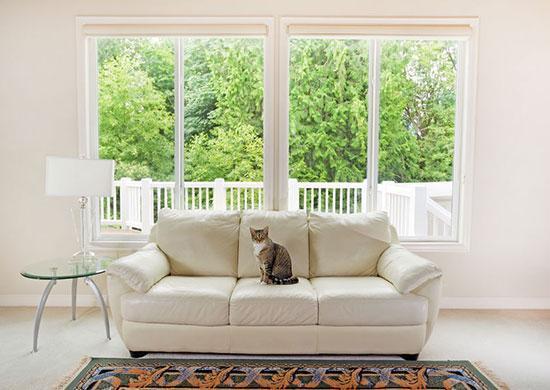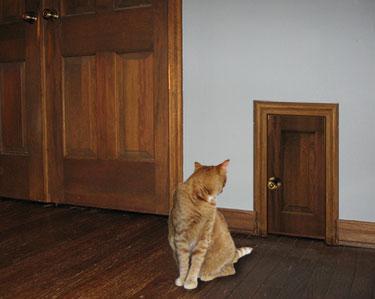This content is archived from the Feline Nutrition Foundation
It's My Cat's House, I Just Live There
- Updated: Sunday, May 26, 2019 02:38 PM
- Published: Monday, December 14, 2009 11:33 AM
- Written by Margaret Gates
 There's a movement in housing design to include features to enhance accessibility. Architects and designers are responding to the need for houses with features to make life easier and safer as one gets older, or if you become disabled.
There's a movement in housing design to include features to enhance accessibility. Architects and designers are responding to the need for houses with features to make life easier and safer as one gets older, or if you become disabled.
Wider doors for wheelchairs, handholds in the shower and spaces left for the addition of an elevator. It shows designers are thinking about how houses are really used, rather than just what looks good.
But, I wish to register a complaint.
The majority of people in the US own pets, yet houses are designed with complete disregard for this fact. If homes are to become more user-friendly, builders must recognize that creatures other than humans use them. Here's my list of things to consider.
Bathrooms. Pet parents aren't the only ones who have to go. If I were designing a bathroom, one of my top considerations would be the space for the litterbox. And this means a built-in space in every bathroom in the house. People end up putting the litterbox in some spot that's out of public view, like the laundry room. Then you end up with a cat that starts house soiling because the spin cycle in the washing machine engaged while the cat was doing its business. Why would any sane cat go back to The Litterbox of Ultimate Terror?
Open floor plans with no way to block off rooms. If kitty doesn't want to be caught, you can end up running in circles – sometimes up one set of stairs and down another – trying to round up your critters. I'd suggest hidden screens or partitions that could be pulled out when needed.
Double-door closets that can be pulled open by hooking a paw underneath. And no way to secure them other than tying the doorknobs together. Magnets don't stop cats getting into The Small Forbidden Room of Mystery and Intrigue.
 Why aren't there cat doors inside the house? You close off a room to keep heat in or noise out. The cat wants in, then out, then in, etc. I want a miniature door that looks just like the big one – made out of wood with door frames and a doorknob that locks – for the cat. Something that looks like it was designed to be there, an integrated part of the house. Not like you cut a hole in the wall and put a plastic flap in it. Every room should have a small second door.
Why aren't there cat doors inside the house? You close off a room to keep heat in or noise out. The cat wants in, then out, then in, etc. I want a miniature door that looks just like the big one – made out of wood with door frames and a doorknob that locks – for the cat. Something that looks like it was designed to be there, an integrated part of the house. Not like you cut a hole in the wall and put a plastic flap in it. Every room should have a small second door.
I would like interior doors to have a small horizontal window about twelve inches from the bottom. That way you could tell if a cat is lurking on the other side just waiting to dash out. Plus, you wouldn't be violating privacy. Well, unless you got down on the floor to peer through.
Then there's dining. There's a dining room for people. It's rarely a room in which you want kitty to chow down. Pets usually get fed in the kitchen, underfoot. Cats need a place to eat where they feel safe. If they're insecure, they won't eat or will gulp it down too quickly, which leads to barfing. This becomes more important if you're feeding raw cat food and want to keep the place separate from areas where human food is prepared or consumed. Feed raw meaty bones or frankenprey, and the cats are running off with their meals. Let's have a small, quiet and easily-cleaned room as the pet dining room. It could double as a place for a sick animal that needs to be kept isolated and quiet.
Additional Reading
Some of the problems cats have adapting to life indoors could be eliminated – or at least reduced – by having environments that take their needs into consideration. House designs that make things easier for the human side of the pet-human relationship would go a long way toward keeping pets and people happy in their homes.
If you're an architect, or know one, please pass these ideas along. Someday, we may get to choose senior-friendly, child-friendly and pet-friendly homes.
Oh, and by the way, why are electrical outlets placed at the approximate height of a spraying cat?
Margaret Gates is the founder of the Feline Nutrition Foundation.




